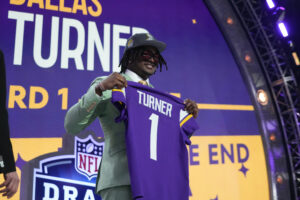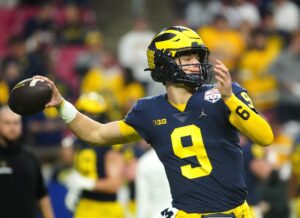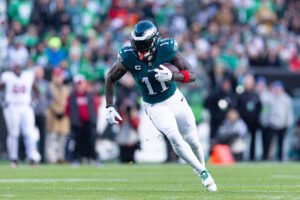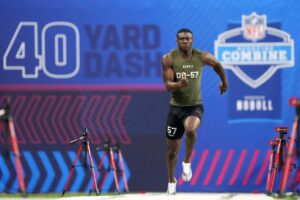In football, there are games that will test a team’s will to win on the road, away from the comfort of home, against a determined playoff team. Fundamental will and mentality may direct a game more than any statistical outlier found. The most straightforward metrics at the end will reveal the team who put up a more determined fight through 60 minutes. And this is where the Kansas City Chiefs week nine problems began; they were decent, they had inspirational plays, but the Dallas Cowboys beat them on every statistical trajectory in all three units. In perception, the Cowboys out-hustled the Chiefs with their season on the line, while KC meandered on the field attempting to sporadically establish patterns of success.
Statistically, the same theme rang true on all zones of the field. Dak Prescott threw at will, the Cowboys defense tore apart the Chiefs running game behind Sean Lee’s 12 tackles, and punter Chris Jones pinned the Chiefs inside of the 20-yard line four times. The Chiefs week nine stats and charts reveal a team that was sporadic, and thus ineffective on any attempt to land a momentum changing play. The Cowboys bounced back every single time and derived a resounding win.
Kansas City Chiefs Week Nine Stats and Charts – The Stars are Dimming
Chaos Theory
The Chiefs walked into this game with momentum from their Monday Night Football victory over the Denver Broncos. Although the game was in Dallas, the Chiefs had a plethora of fans in attendance. To put the fan amplitude into context, the away disadvantage for the Chiefs was minimal. However, the Cowboys were perfectly comfortable at home in AT&T Stadium. All weighed out, chaos advantage due to the crowd was minimal.
The first four drives of the games featured four decisive punts as both defenses dominated quarter number one. However, the field position was constantly moving toward the Cowboys favor. It was only a matter of time before the Cowboys had the opportunity to score. They did so on the fifth drive, only needing to drive 61 yards for the Cole Beasley touchdown reception. That momentous touchdown was the opening of the flood gate; the Cowboys took control of chaos and never let it slip.
Despite efforts from both Travis Kelce and Tyreek Hill, the Chiefs never gained consistent momentum, functionally dwindling opportunity away. The defense, however, never let the Cowboys dominate in intrinsic fashion throughout much of the first or second quarter. Prescott and Ezekiel Elliott had to fight for every yard. Through one quarter, Elliott had a mere 23-yards on six carries. More importantly, those yards did not create points; during the opening touchdown drive, he only carried the ball once.
Although the Cowboys had momentum, head coach Jason Garrett was forced to break from the game plan. Thus, the biggest indictment was on the Chiefs slow offensive start. Their first score, a field goal, took five minutes and 11 plays. Although the score was 7-3, the Chiefs had let opportunity for more explosive plays slip.
Again, Elliott dominated for a moment in the second quarter, but after Garrett opted to initiate two short passes to Dez Bryant, the Cowboys punted. They too were taking their share of wasted yardage from Elliott’s beginning push.
However, it was only a matter of time before the Cowboys broke the hearts of the Chiefs defense. After the sole Chiefs sack of the game by Frank Zombo, Prescott completed a 21-yard pass to Bryant over the deep left cone. He then hit Terrance Williams for another 56 yards. A drive that began as a potential third down stop turned into a full-blown travesty as Prescott dashed in for a ten-yard touchdown.
Elliott had no influence on the drive, this was all on Prescott and Chiefs blowing coverages. In fact, despite the 11 rushes for 39 yards by Elliott in the first half, none of those yards turned into points.
Andy Reid, however, had invented one of the smartest football plays to let Hill score. The new type of Hail Mary pass put Kelce and Demarcus Robinson deep downfield and Hill in the short middle. Hill received the ball with no defenders around him, while the receivers who had proceeded ahead of him blocked defenders in a prevent. Hill went untouched into the end zone to spark a momentum shift before half.
The momentum carried on into the second half for the Chiefs. Alex Smith and Kelce connected twice, including a touchdown, while Kareem Hunt finally started to penetrate the Cowboys defense. As the Chiefs took the 17-14 lead early in the third, they had a chance to swing control.
Alas, Elliott finally turned yards into points and chaos went right back into the Cowboys control. The second half story for the Chiefs was a defense gashed by grinding runs from Elliott while Smith ineffectively dumped passes into the short lanes. Reid was forced to strategize from behind.
Putting the cherry on top, Jeff Heath was the first player to intercept Smith in 2017 with five minutes left in the fourth. The Cowboys defense had assumed total control.
A Failure to Coordinate
The story of the offense was much in the lines of frustratingly inefficient third down plays and muddied coordination. For a second time this year, the Chiefs emphatic pass game was exposed when the run game was defunct. Formations and precedent could not be established as Hunt netted only 37 yards on nine carries. Hill did no better with four carries and nine yards.
The run game’s lack of production was made evident in the passing game and second half play-calling. After the opening half touchdown pass to Kelce, the Chiefs drive structure was torn apart. The Cowboys reasserted a 21-17 lead, and Reid presumably was thrown into a dichotomous corner of wanting to pass; the Chiefs ran once to Charcandrick West after that point.
To cement how important the run game is for the Chiefs, and the Cowboys impressive defensive performance, since 2013 (the year Smith took over as starting quarterback), the Chiefs are 2-6 when total team rushing yards are under 70. In that same stretch, the Chiefs are 3-13 when their rushing attempts fall below 20 in a game. Both criteria were met yesterday and are included in the loss column.
Hunt very well might be hitting a rookie wall. There have only been two running backs that completed a rookie season at Hunt’s current trajectory of 2,000 yards from scrimmage: Eric Dickerson in 1983, and Edgerrin James in 1999. Hence, the offense needs to spread out the onus of who receives play emphasis, lest the Chiefs expect the unprecedented to happen.
One of the other games the Chiefs landed only 70 total rushing yards was the loss to the Pittsburgh Steelers in early October. In that game it was noted that the Chiefs deep ball pervasively fell due to the lack of precise plays establishing each other. The same theme rings true against the Cowboys as Smith completed only two deep passes for 44 yards on six attempts. Defenses now have a methodology to shut down explosive plays.
In fact, the explosive plays were entirely negated in terms of function. Two of the three in the first half were the two deep passes, while the third was Hill’s short pass turned into the Hail Mary touchdown. Hunt netted another with a 19-yard run to open the second half, and after that, they all dried up.
Not much else needs to be said about the Chiefs offensive inefficiency. Passes dinked and dunked, athletic players were soundly tackled by an impressive Cowboys defensive effort, and the run game never found its groove. Those typical athletic players who create explosive plays from short yardage were stopped. The implication is straightforward: the offense did not execute as intended.
Second Half Woes Continue
The Chiefs defensively committed one egregious error that stood above the rest: a failure to assert domination by creating a single turnover. The only turnover of the game was at the hands of Heath intercepting Smith. The defense, more or less, swam along the path of the game hoping not to lose, instead of playing aggressively to take the onus of chaos in control.
Prescott threw at will in the first half, and once the offense was fine tuned in the second half, turned those completions into points. As mentioned before, 11 of Elliott’s carries and 39 yards came in the first half. The remaining 54 yards and 16 carries came in the second half.
One of the most concerning signs is a defense that plays great at times, but inconsistently. They fall more to the whims of coordinators figuring out how to puncture holes. Without Eric Berry, the secondary is missing an essential leader who coordinates everything. Marcus Peters has had special moments on the season, but at other times he has lost technique. Daniel Sorensen and Ron Parker are excellent tacklers, but they do not coordinate the same way Berry did.
The implication against the Cowboys was Williams catching all nine of his targets uncontested. A typically physical secondary has gotten tired out, unable to maintain a highly poignant attack throughout 60 minutes. And again, for the eighth week in a row, the Chiefs onus is on a missing pass rush. Zombo’s sole sack of the game also marked the end of pressure from the Chiefs. Chris Jones was able to effectively push around Prescott in the first half, but landed zero sacks. Even the typically fired up Tamba Hali slowed throughout the game, albeit he is returning from the physically unable to perform list.
The Chiefs defense initially quelled the explosive plays, but they were derived in a painful way. The Cowboys converted seven of 12 third downs, grinding and draining the blood from the Chiefs defense. While Elliott only landed two explosive runs, Alfred Morris gained another, and Prescott gained another two explosive plays including his touchdown run. Mobile quarterbacks are now habitually escaping contain and gashing the Chiefs.
Meanwhile, Prescott taunted six explosive passes. He had all day to pass as the Cowboys offense evolved. This is not even a schematic problem anymore as the Chiefs lack matching the effort or wit of the other team. While Garrett constantly evolved, Bob Sutton stayed stagnant in the defensive enthusiasm.
Even more woefully, the Cowboys run game and pass game attacked every lane and cone successfully; there were no outliers who received a ‘good effort’ award. As the Chiefs defense has aged and fallen to injury, they can no longer rely on turnovers and random points of chaos to win games. They ought to evolve to smart and intelligent football that builds upon layers of schematic fit to win games when the turnovers do not fall.
The implication of a defense that cannot create turnovers is a 6-12 record since 2013. Add at least one takeaway, the Chiefs are 18-20.
Main Image:






